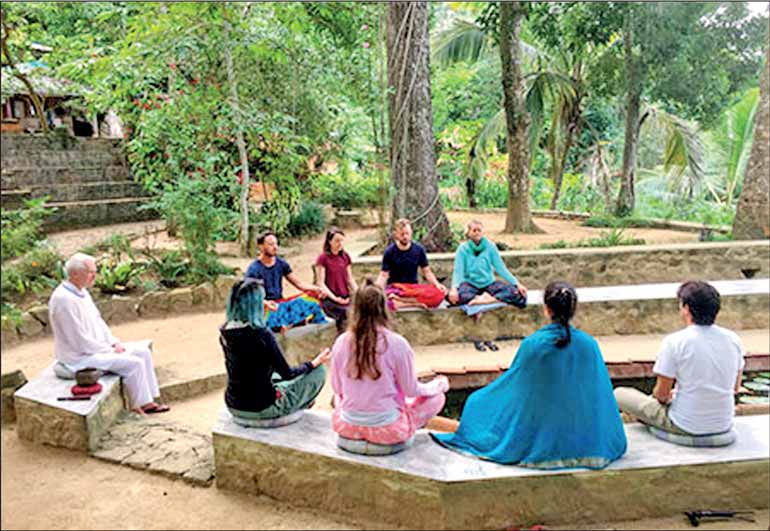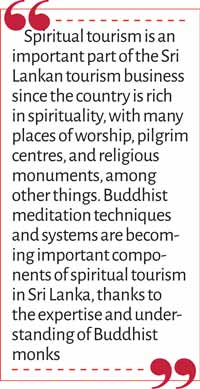Tuesday Dec 23, 2025
Tuesday Dec 23, 2025
Wednesday, 23 March 2022 00:15 - - {{hitsCtrl.values.hits}}

Nilambe Buddhist Meditation Centre
Spiritual tourism entails visiting sacred and spiritual places of worship of many religions (churches, temples, synagogues, and mosques) in order to receive spiritual experience and enlightenment in order to improve one’s physical, mental, and spiritual wellbeing.
temples, synagogues, and mosques) in order to receive spiritual experience and enlightenment in order to improve one’s physical, mental, and spiritual wellbeing.
The World’s Top 10 Spiritual Destinations are Varanasi – India, Machu Picchu – Peru, Kyoto – Japan, Ubud, Bali – Indonesia, Jerusalem – Israel, Uluru – Australia, Angkor Wat – Cambodia, Bhutan, Ancient Egypt and Delphi – Greece.
From 2021 to 2028, the Religious Tourism Market is expected to rise at a CAGR of 6%, from $ 1,071 million in 2020 to $ 1,704.2 million in 2028.
Spiritual tourism is an important part of the Sri Lankan tourism sector because the country is rich in spirituality and has several places of worship.
Meditation is a technique for connecting with one’s inner self. Buddhist meditation techniques are systems that energise and produce focus, clarity, energising energy, and a peaceful observation of the true nature of things. People who engage in a specific meditation practice learn about their mind’s patterns and habits, and the practice allows them to build new, more positive ways of being.
Spiritual tourism is an important part of the Sri Lankan tourism business since the country is rich in spirituality, with many places of worship, pilgrim centres, and religious monuments, among other things. Buddhist meditation techniques and systems are becoming important components of spiritual tourism in Sri Lanka, thanks to the expertise and understanding of Buddhist monks.
Meditation centres for travellers to see the realities of life
Outside of Colombo, Sri Lanka Tourism has identified about 20 meditation centres that might provide an opportunity for travellers on an excursion to see the realities of life.
Ridee Vihara – the International Buddhist Tourism Centre was founded in 2018 as part of the World Tourism Day celebrations and is located around 125 kilometres from Colombo, sitting atop the old cave temple of Ridi Vihara. Furthermore, at Ridee Viharaya in Kurunegala, the First International Buddhist Tourism Conference with the topic ‘A Simple Life and Middle Path for Responsible Religious Tourism Development’ was successfully concluded.
The goal of establishing international Buddhist tourism centres is to provide Buddhist and non-Buddhist visitors to Sri Lanka with a better understanding of great Buddhist philosophy, culture, Buddhist ethics, and Buddhist spirituality. The International Buddhist Tourist Centre will serve as the focal point for future Buddhist tourism development in Sri Lanka.
The Ridee Viharaya, which means “Silver Monastery” in Sinhala, is well-known and loved for its Sinhala arts, wall paintings, architecture, and distinctive ivory carvings, as well as wood and metal work. Many of the relics date from Sri Lanka’s late medieval period, which is known as the Kandyan period (1592-1815).
Rockhill Hermitage – The Rockhill Hermitage is a meditation centre in the central mountains, close to Kandy, and easily accessible from Colombo. The surrounding landscape is unaffected by its presence and provides breathtaking views as well as opportunities to learn about the country’s lush tropical fauna and flora.
Kandy, and easily accessible from Colombo. The surrounding landscape is unaffected by its presence and provides breathtaking views as well as opportunities to learn about the country’s lush tropical fauna and flora.
It is a non-profit organisation committed to charity work that is supported by the Sri Lankan Government. The complex is built on a mountainside and includes a monastery, a men’s section, a nun’s area, and a women’s area.
The monastery has its own pure spring water supply. The centre’s name comes from the various rock blocks and prisons in the monastery’s local neighbourhood, which have formed several natural caves on the monastery grounds that are also used for residential and meditation functions.
All meditation classes are intensive and taught by Ven. Kassape, the Centre’s founder and teacher. He is a seasoned meditation teacher with over 35 years of experience teaching Vipassana meditation and Dhamma to locals and Westerners interested in Buddhism. When foreign visitors are present, he teaches in both Singhalese and English. He is well-known abroad, having travelled widely in recent decades to teach meditation and introduce people to Buddhism.
A library, as well as caverns and student homes, are strewn over the tranquil 15-acre grounds. The term “Rockhill” comes from the large boulders and rocks that make up several of the caves. The Rockhill Hermitage is one of the few retreat places in Sri Lanka that allows women to live alone in modest cottages surrounded by nature. At the start, 10-day intensive meditation workshops are held.
Kanduboda Meditation Center – In Sri Lanka, the 2,500th Buddha Jayanti saw a huge revival of Buddhism. Vipassana Meditation received renewed attention. Sir John Kotelawala, the Prime Minister at the time, had discussions on what could be done. During a discussion, the Burmese ambassador at the time, U Ba Lwin, suggested that the best thing to do was to promote Insight meditation techniques to Sri Lankans, as this was the only way to bring them immense satisfaction. It was established the Lanka Vipassana Bhavana Samitiya (Lanka Insight Meditation Society).
A Burmese team of four theros led by U Sajata, Mahasi Sayadaw’s intimate helper, arrived in Sri Lanka on 28 July 1955. A comprehensive meditation centre was established in around six months at Kanduboda, a quiet suburb 25 kilometres from Colombo, under their leadership and with the help of residents.
The Kanduboda Siyane meditation centre was officially opened on 8 January 1956. Ven. Kahatapitiye Sumathipala thero was elected as the meditation centre’s chief instructor and in-charge as a mark of respect for his enormous contribution to its establishment.
Foreigners and locals alike are welcome to come to the facility for free to explore the fountain of wisdom inside themselves through Vipassana (Insight).
The centre teaches Vipassana meditation in the Mahasi Sayadaw (Burmese) style. At any given moment, the meditation centre can hold up to 70 people. The centre is supported by contributions, thus lodging, meals, and services are all provided free of charge. Programs are meant for people who want to meditate for a few weeks or months.
Nilambe Buddhist Meditation Centre – Nilambe, located just outside of Kandy, is a well-known resort with an intriguing and extensive program. You must completely disengage from the connected world by turning off your phone. There are no drop-in sessions, so check out their upcoming programs and commit to joining at the beginning of a retreat and staying until the finish.
Every morning, you wake up to the sound of a gong and are escorted through a guided meditation. You must also complete a few chores referred to as “working meditation.” What makes this experience stand out is how deeply it immerses you in Dhamma practice.
The meditation centre was founded with the goal of spreading Lord Buddha’s wonderful teachings to people of all races and faiths. They have over 50 years of meditation expertise and specialise in Vipassana meditation, which is a technique that allows one to view life as it is.
Paramita International Meditation Center – The Paramita Meditation Centre is situated on the site of a former tea plantation and is perched on top of hill Kadugannawa with panoramic views of the sweeping valleys below. Long-tailed Macaques dwell among squirrels, indigenous birds, and their human counterparts on its terraced hillside, richly planted with old tea bushes, pepper vines, jackfruit, avocado, nutmeg, and clove trees. The Centre is intended to provide as a spiritual home for both resident monks and guests.
Many people choose this spot to purify their souls away from the rush and bustle of Colombo, judging from the surroundings and space available.
The Centre was created specifically for persons seeking the Dhamma, or Buddha’s teachings. It is providing an increasing number of chances for individuals who travel to Sri Lanka with the intention of learning and practicing the Dhamma and developing their minds.
For both concentration meditation (Samatha) and insight meditation (Insight meditation), the centre provides systematic instructions and an ideal setting (Vipassana). A well-equipped Buddhist Library is available for individuals who wish to further their understanding of the Dhamma and for other purposes.
Sri Subodharama international Meditation Center – The tranquil Valley, Ambuluwawa, Nilambe, and Peradeniya are all located in Sri Lanka’s hill area, encircled by the green misty mountains that create the serene Sri Subodha Meditation Centre. More than 1,500 youngsters attend the Sunday Dhamma School to study and practice the Buddha’s teachings.
Subodharama Sasana Seva Society manages Sri Subodharama, which is a charitable institution.
Dhamma Kuta – A meditation centre where S.N. Goenka teaches Vipassana meditation courses in the Sayagi U Ba Khin style.
The centre is nestled on a steep slope with stunning views and a cool atmosphere in an abandoned tea estate. Only intense 10-day meditation workshops for both men and women are held here. Except for interviews with the teacher, no one is allowed to speak during the classes, and there are multiple group sittings throughout the day.
The courses are free of charge, although donations are appreciated. Because the classes are frequently full out, it is best to book ahead of time. It is not possible to stay here before or after classes. Peradeniya is 5 kilometres away. From Kandy, take a Deltota or Galaha bus to Mowbray, Hindagala. Take a three-wheeler up the mountain from there or walk for more than half an hour. In the low country, there are two more Vipassana Meditation Centres, one of which is called Dhamma Sobha and is located in Kosgama, near Avissavella.
Amawathura Meditation Center – Before being turned to a meditation centre, the Mahamewna Amawathura Bhavana was an old residence. It is so well-known that it has become a distinguishing landmark on the way to Kaduwela.
Venerable Kiribathgoda Gnanananda collected artisans from all across the country and, with only the generosity of his disciples, began the construction of a new edifice that still exists today.
The Bhavana Asapuwa was constructed on several levels. The Great Stupa, which is encircled by eight smaller stupas on columns, is devoted to the summit; it is a wonderful sight that can be revered even from afar.
Above the beautiful entrance on the roof-top, the Sacred Bodhi Tree has been put in clear view of passers-by. The tree stands out as an oasis of life in the midst of the intimidating structure in its small Bonsai form.
Arankele Forest Monastery – Spend the day at Arankele Monastery if you’re seeking for a haven of solitude and quiet. Its verdant sylvan surrounds will instantly and fully calm and revitalise you. According to legend, the location was previously an ancient forest monastery that was never meant to be a centre.
Arankele is an exaggerated name for a hermitage where Arahants lived. Arahat Malyadeva thero, a well-known Buddhist monk, is said to have stayed here. In the hermitage now, about 18 bhikkus practice traditional and new meditation practices. The hermitage was said to have been established in the eighth century.
The monks who live here are known as Pansukulika, which translates to “rag-robes.” The monks accept a vow to wear only rag robes in this place. The fact that these structures are raised by platforms built by large stone retaining walls in pairs and joined by a stone bridge is a unique characteristic. The buildings are also encircled by water troughs, which help to keep the interiors cool.
Archaeologists discovered ediating promenades pools and winding roads at the site, as well as Jantagara or hot water baths near the site’s entrance.
Locals and visitors alike go to the Arankele forest monastery. It is the ideal location for visitors who have come to Sri Lanka specifically to visit tranquil and quiet places. The first visit to the Arankele woodland hermitage will leave you utterly refreshed and calm.
It is considered one of Sri Lanka’s best forest hermitages. The hermitage lies in the Ganewatte area of Sri Lanka’s Kurunegala district.
Dekanduwala Meditation Centre – The meditation centre, which spans 20 acres, was founded in 1993 by Ven. Kirama Wimalajothi Thero to fill a vacuum in the community for a meditation centre that could serve both monks and lay people, both local and foreign.
Since 1994, the Centre has hosted a number of Dhamma training programs. In 2002, in-house meditation programs and educational programs, including dhamma and counselling sessions, were started for both international and local women. In 2003, a two-week Temporary Ordination was established to provide fundamental knowledge in Dhamma, meditation, and social service.
The Dhamma Training and Meditation Centre will be expanded into a full-fledged bhikkuni training centre with an international Buddhist educational faculty, where local and foreign bhikkunis and dasa sil mathas who aspire to be ordained will be taught extensive English, communication skills, and Buddhist research studies. A library and a hostel for foreign bhikkunis are also planned to aid their efforts.
Sanatha Suwaya – In Sri Lanka’s Central Province, Sanatha Suwaya is a meditation and holistic health institution that offers training and practice in mindfulness traditions and holistic therapies. Sanatha Suwaya is meant to be a venue for debate, learning, mental and physical exercise, exploration, growth, dissemination, communion, and exposure, among other things.
Sanatha Suwaya is a non-religious organisation that does not endorse any particular philosophy. As a “wellness” centre, they strive to provide a peaceful environment in which a range of healthy experiences and services can be provided.
Long and short-term guests will have the opportunity to participate in guided meditation sessions, extended retreat programs, and daily “like practices.” “Like practices” are methods aimed at improving human health through both mental and physical means. Yoga, Reiki, Ayurveda, and acupuncture are just a few examples of healing systems.
Pagoda Meditation Centre – The Pagoda Meditation Centre, located at 49/2 2nd cross street, Pagoda Road in Nugegoda, was founded by well-known Ven. Olanda Ananda, a senior Dutch monk. He is conversant in Sinhala and has been teaching meditation in Sri Lanka and overseas for many years.
The Vipasanna International Meditation Centre is located in Sri Lanka. Many Western monks and laypeople have lived there for a long time, and it is frequently visited by Western monks who are staying in Colombo for a few days to extend their visas, etc. Supportive, tidy, clean, and quiet. In the diplomatic district of Colombo. It’s a good spot for laypeople to meditate. For Colombo, it was rather peaceful. Women are housed in their own wing.
Nisala Foundation – Meditation, Yoga, and Spiritual Retreats. In Ududumbara, Sri Lanka’s Central Highlands, the Nisala Foundation is a secular venue that specialises in yoga and consciousness-related disciplines. It is open to spiritual practitioners at all levels, from beginning to intermediate to advanced. It was founded in 2014 and offers both traditional and modern spiritual techniques to help seekers achieve a deep state of awareness and energetic purification. Due to the quality of its teaching, the Centre is becoming a popular destination for visitors to Sri Lanka who are looking for a break from their daily routine to visit and engage in secular yet profound spiritual practices, as well as enter into a field of awareness rooted in deep relaxation, peace, and awareness.
The Centre is positioned facing the majestic Knuckles Mountain range, surrounded by a forest reserve, paddy fields, and a few houses that make up an antique hamlet, to top off the quality of instruction. It is an exquisite setting for a spiritual escape, away from the rush and bustle of the metropolis. (Source – https://www.srilanka.travel/)
Spirituality can help people cope with physical or mental pain as well as other life challenges by promoting tight family and friendship relationships. It can also provide people with a strong sense of belonging, especially if they are a part of a spiritual group or community.
Drawbacks of religious travel
The drawbacks of religious travel, issues such as poor infrastructure, harassment, begging, heritage trafficking, restricted community participation, cultural degradation, and government administrations’ lack of attention to the sector are all obstacles to religious tourism development in the studied area.
Diversity, people, cultural heritage, festivals, spiritual experiences, ayurveda, nature and wildlife, sports and adventure, beaches, hotels, and ayurveda are some of Sri Lanka’s comparative advantages.
(The writer holds a DBA (Tourism and Hospitality Management), and is a Senior Lecturer at Business School, Sri Lanka Technological Campus (SLTC).)